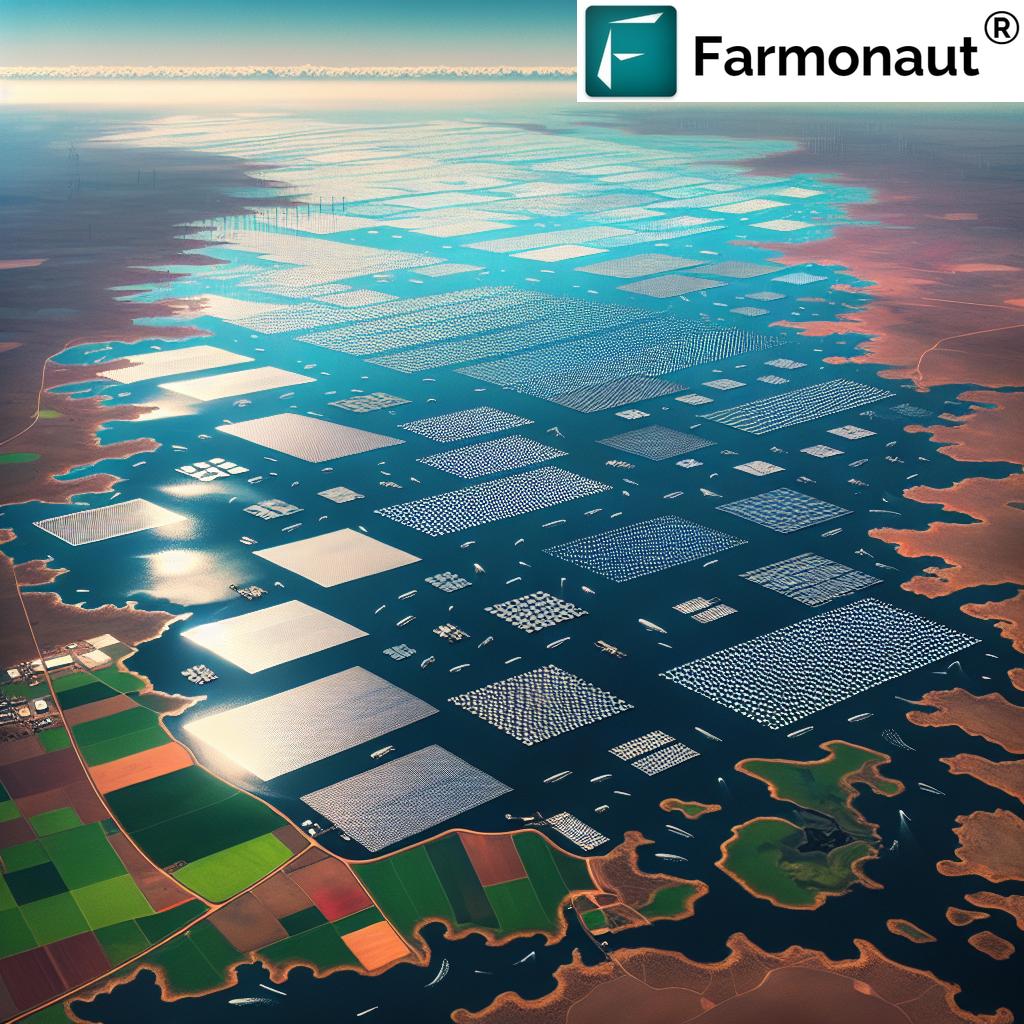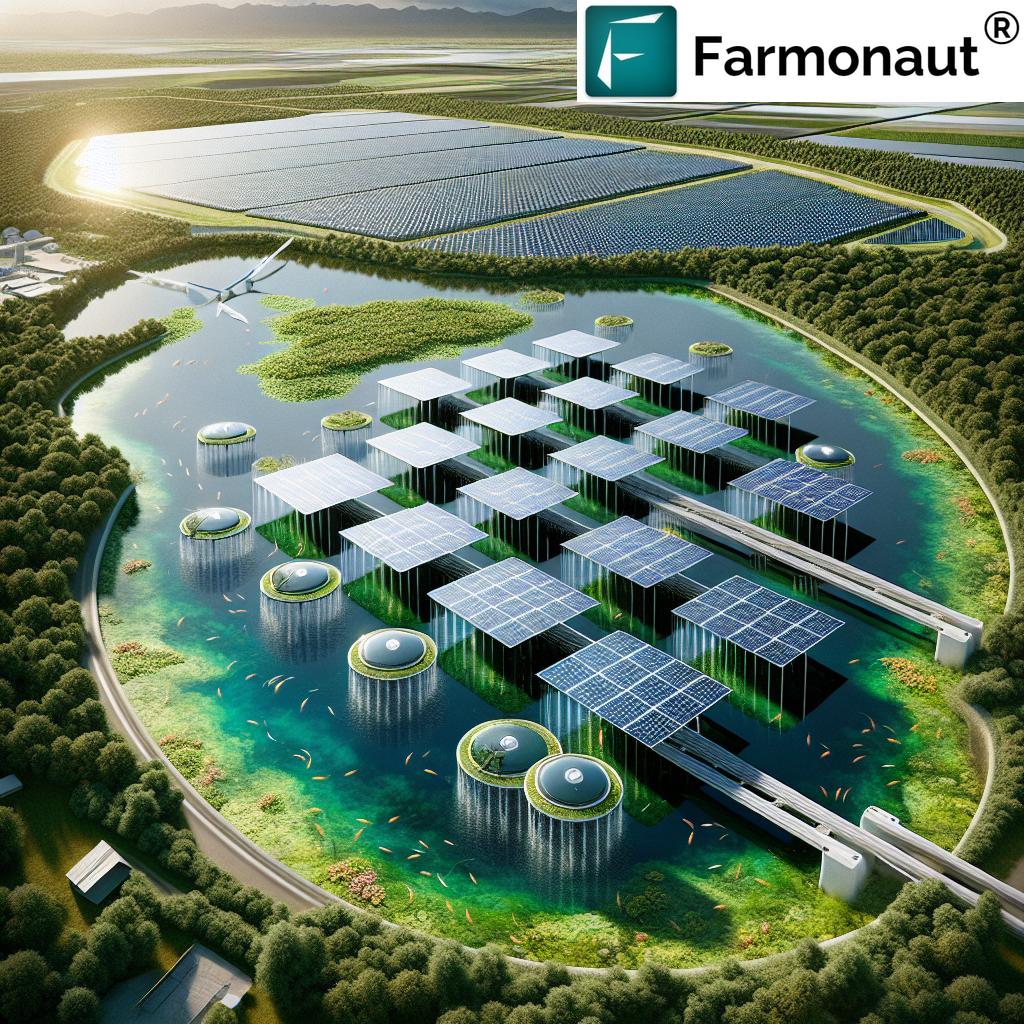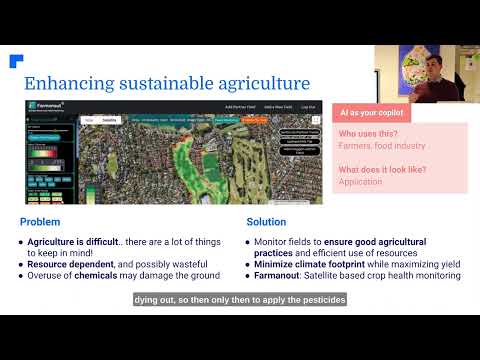Revolutionizing Australia’s Sustainability: Innovative Floating Solar Technology Tackles Water and Energy Challenges
“Floating solar panels in Australia can reduce water evaporation by up to 70% while generating clean electricity.”
In the land down under, we’re witnessing a remarkable transformation in the way we approach renewable energy and water conservation. Australia, known for its vast landscapes and abundant sunshine, is now turning to an innovative solution that addresses two of our most pressing challenges: energy production and water scarcity. Welcome to the world of floating solar technology, a game-changing approach that’s set to revolutionize Australia’s sustainability efforts.

As we delve into this exciting development, it’s crucial to understand the context and potential impact of floating solar technology on Australia’s renewable energy landscape. At Farmonaut, we recognize the immense potential of this technology to transform the Australian renewable energy sector, particularly for communities and industries near water sources. Our satellite-based farm management solutions align perfectly with the goals of sustainable resource management, making us well-positioned to appreciate and analyze this innovative approach.
Understanding Floating Solar Technology
Floating solar technology, also known as floating photovoltaics or “floatovoltaics,” involves installing solar panels on floating structures on water bodies such as reservoirs, lakes, and even coastal marine areas. This innovative approach to solar power generation combines energy production with water conservation, offering a dual benefit that’s particularly valuable in a country like Australia, where both energy demand and water scarcity are significant concerns.
Key Components of Floating Solar Systems
- Floating Platform: A specially designed structure that keeps the solar panels afloat and stable on the water surface.
- Solar Panels: High-efficiency photovoltaic panels optimized for use over water bodies.
- Anchoring System: Ensures the floating array remains in place despite wind and water movement.
- Power Transmission: Underwater cables that transmit the generated electricity to the shore.
- Inverters and Transformers: Convert the DC power from the panels to AC power for grid use.
The integration of these components creates a robust system that can harness solar energy while providing additional benefits to the water body it occupies.
Advantages of Floating Solar Technology in Australia
The adoption of floating solar technology in Australia offers numerous advantages that address specific challenges faced by the country:
1. Land Conservation
In a country where land use is a critical consideration, floating solar provides an excellent alternative to traditional ground-mounted solar farms. By utilizing water surfaces, we can preserve valuable land for agriculture, habitat conservation, or urban development.
2. Water Conservation
One of the most significant benefits of floating solar arrays is their ability to reduce water evaporation. The panels shade the water surface, potentially reducing evaporation by up to 70%. In a country prone to droughts, this water-saving aspect is invaluable.
3. Improved Solar Panel Efficiency
The cooling effect of water on the solar panels can increase their efficiency by up to 10% compared to land-based systems. This improved performance translates to higher energy yields and better return on investment.
4. Algae Growth Reduction
By limiting sunlight penetration, floating solar installations can help control algae growth in water bodies. This natural water treatment effect can improve water quality for various uses, including irrigation and drinking water supply.
5. Synergy with Existing Infrastructure
Floating solar can be easily integrated with existing hydroelectric dams, creating hybrid power plants that maximize energy production and grid stability.
As we explore these advantages, it’s clear that floating solar technology aligns perfectly with Australia’s sustainability goals. At Farmonaut, we’re excited about the potential synergies between our satellite-based crop monitoring services and the implementation of floating solar technology. Our API could potentially be used to monitor the impact of these installations on surrounding agricultural areas, ensuring that the benefits of floating solar are maximized while minimizing any potential disruptions to farming activities.
Innovative Features of Australian Floating Solar Solutions
Australian engineers and researchers have been at the forefront of developing cutting-edge floating solar solutions tailored to the country’s unique environmental conditions. Some of the innovative features include:
1. Integrated Rainwater Harvesting
Many floating solar installations in Australia are being designed with integrated rainwater harvesting capabilities. This dual-purpose approach not only generates clean electricity but also collects and stores rainwater for agricultural use or to supplement local water supplies.
2. Wave-Resistant Designs
Given Australia’s coastal regions and large inland water bodies, floating solar arrays here are engineered to withstand significant wave action. Advanced mooring systems and flexible connections between panels ensure durability in choppy conditions.
3. Saltwater-Resistant Materials
For installations in coastal areas or saline lakes, Australian engineers have developed corrosion-resistant materials and coatings that prolong the lifespan of floating solar systems in these harsh environments.
4. Wildlife-Friendly Structures
Recognizing the importance of aquatic ecosystems, many Australian floating solar designs incorporate features that provide habitats for local wildlife, such as fish-friendly underwater structures and bird resting platforms.

These innovative features demonstrate Australia’s commitment to developing floating solar solutions that not only generate clean energy but also contribute positively to water conservation and ecosystem health.
“Australia’s floating solar technology integrates rainwater harvesting, potentially increasing water availability for agriculture by 25%.”
Impact on Australia’s Energy Transition
The adoption of floating solar technology is set to play a crucial role in Australia’s energy transition towards a more sustainable future. Here’s how this innovative solution is impacting various aspects of the country’s energy landscape:
1. Accelerating Renewable Energy Adoption
Floating solar installations provide a new avenue for expanding Australia’s renewable energy capacity. By utilizing water surfaces, we can significantly increase the total area available for solar power generation, helping the country meet its ambitious renewable energy targets more quickly.
2. Enhancing Grid Stability
When combined with existing hydroelectric infrastructure, floating solar can create hybrid power plants that offer more stable and reliable energy production. This synergy helps smooth out the intermittency often associated with solar power, contributing to a more robust and resilient electrical grid.
3. Supporting Remote Communities
For remote Australian communities near water bodies, floating solar microgrid systems can provide a reliable and sustainable source of electricity. This technology can reduce dependence on diesel generators, lowering both costs and carbon emissions for these isolated areas.
4. Boosting the Clean Energy Economy
The development and deployment of floating solar technology are creating new jobs and business opportunities in Australia’s clean energy sector. From manufacturing specialized components to installation and maintenance services, this emerging industry is contributing to economic growth while advancing sustainability goals.
At Farmonaut, we’re particularly interested in how floating solar technology can benefit the agricultural sector. Our satellite-based crop monitoring services can help farmers assess the impact of nearby floating solar installations on their water resources and crop health. For more information on how our technology can support sustainable farming practices, check out our API Developer Docs.
Challenges and Solutions in Implementing Floating Solar Technology
While floating solar technology offers numerous benefits, its implementation in Australia is not without challenges. However, innovative solutions are being developed to address these issues:
1. Environmental Concerns
Challenge: There are concerns about the potential impact of floating solar arrays on aquatic ecosystems.
Solution: Australian researchers are conducting extensive environmental impact studies and developing designs that minimize disruption to aquatic life. Some installations even incorporate features that enhance biodiversity, such as artificial reefs beneath the panels.
2. Maintenance and Durability
Challenge: Maintaining floating solar systems in aquatic environments can be more complex than land-based installations.
Solution: Engineers are developing specialized maintenance techniques and robotic cleaning systems designed for water-based operations. Additionally, advanced materials and coatings are being used to improve the durability of components exposed to water and sun.
3. Initial Costs
Challenge: The upfront costs of floating solar installations can be higher than traditional ground-mounted systems.
Solution: As the technology matures and becomes more widespread, economies of scale are reducing costs. Furthermore, the additional benefits of water conservation and improved panel efficiency often justify the initial investment.
4. Grid Integration
Challenge: Integrating large-scale floating solar projects into existing power grids can be technically challenging.
Solution: Australia is investing in smart grid technologies and energy storage solutions to better manage the integration of floating solar power. This includes advanced inverters and control systems that can respond dynamically to grid conditions.
| Aspect | Floating Solar | Traditional Solar Farms | Environmental Impact |
|---|---|---|---|
| Land Use | Minimal land use, utilizes water surfaces | Requires large land areas | Preserves land for other uses, reduces habitat loss |
| Water Conservation | Reduces evaporation by up to 70% | No direct water conservation benefit | Significant positive impact on water resources |
| Energy Generation Efficiency | Up to 10% more efficient due to cooling effect | Standard efficiency | More energy per panel, potentially lower carbon footprint |
| Installation Costs | Initially higher due to specialized equipment | Lower initial costs | Higher upfront investment but potential long-term savings |
| Maintenance Requirements | More complex due to water-based location | Easier access for maintenance | Potential for increased maintenance-related emissions |
| Ecosystem Benefits | Can provide habitat for aquatic life, reduce algae growth | Limited ecosystem benefits | Potential positive impact on aquatic biodiversity |
This comparison clearly highlights the unique advantages of floating solar technology, particularly in addressing Australia’s specific environmental challenges. The water conservation aspect alone makes it a compelling option for a country often grappling with drought conditions.
Future Prospects and Potential Applications
The future of floating solar technology in Australia looks incredibly promising. As we continue to innovate and refine this technology, several exciting prospects and potential applications are emerging:
1. Large-Scale Coastal Installations
Australia’s extensive coastline offers immense potential for large-scale floating solar farms in sheltered marine environments. These installations could provide clean energy to coastal communities while potentially acting as wave barriers to protect shorelines from erosion.
2. Integrated Agriculture Solutions
Combining floating solar with aquaculture or hydroponics systems could create highly efficient food production facilities. These integrated systems could use the generated electricity to power pumps, lighting, and climate control systems for year-round crop production.
3. Desalination Powered by Floating Solar
As water scarcity becomes an increasing concern, floating solar could power energy-intensive desalination plants. This synergy could provide both clean water and renewable energy to coastal communities, addressing two critical needs simultaneously.
4. Hydrogen Production
The abundant clean electricity generated by floating solar farms could be used to power electrolyzers for green hydrogen production. This could position Australia as a leader in the emerging hydrogen economy, offering a clean fuel alternative for industries and transportation.
At Farmonaut, we’re excited about the potential synergies between floating solar technology and precision agriculture. Our satellite-based farm management solutions could be integrated with floating solar installations to optimize both energy production and agricultural water use. To learn more about how our technology can support sustainable farming practices, check out our  and
and  .
.
Regulatory Framework and Government Support
The successful implementation and growth of floating solar technology in Australia depend heavily on supportive regulatory frameworks and government initiatives. Here’s an overview of the current landscape:
1. Renewable Energy Targets
Australia’s commitment to increasing its renewable energy capacity has created a favorable environment for floating solar projects. Many states have set ambitious renewable energy targets, driving investment in innovative solutions like floating solar.
2. Environmental Regulations
Australian environmental agencies have developed specific guidelines for assessing and approving floating solar installations. These regulations ensure that projects are environmentally sound and do not negatively impact aquatic ecosystems.
3. Financial Incentives
Various government incentives, including grants and tax benefits, are available to support the development of floating solar projects. These financial supports help offset the initial higher costs associated with this technology.
4. Research and Development Funding
The Australian government is actively funding research into floating solar technology through universities and research institutions. This investment is driving innovation and helping to solve technical challenges specific to the Australian context.
As the regulatory landscape continues to evolve, we at Farmonaut are committed to staying informed and adapting our services to complement the growth of floating solar technology. Our data-driven insights can help project developers and policymakers make informed decisions about the placement and impact of floating solar installations.
Community Engagement and Social Impact
The success of floating solar projects in Australia isn’t just about technology and regulations; it’s also about community acceptance and social impact. Here’s how floating solar is engaging with and benefiting local communities:
1. Education and Awareness
Many floating solar projects include educational components, such as visitor centers or school programs, to help the public understand the technology and its benefits. This awareness-building is crucial for fostering community support.
2. Job Creation
The floating solar industry is creating new job opportunities in installation, maintenance, and related services. This is particularly valuable for rural communities near water bodies where such projects are often located.
3. Energy Security
By providing a local source of renewable energy, floating solar installations can enhance energy security for nearby communities, reducing dependence on distant power plants and vulnerable transmission lines.
4. Recreational Opportunities
Some floating solar projects are being designed with dual-use in mind, incorporating features like fishing platforms or boardwalks that allow communities to continue enjoying recreational access to water bodies.
At Farmonaut, we believe in the power of technology to transform communities positively. Our satellite-based solutions, combined with innovations like floating solar, have the potential to create more resilient and sustainable rural communities across Australia.
Conclusion: A Bright Future for Floating Solar in Australia
As we’ve explored throughout this article, floating solar technology represents a groundbreaking approach to addressing Australia’s energy and water challenges simultaneously. By harnessing the power of the sun while conserving precious water resources, this innovative solution is paving the way for a more sustainable future.
The benefits of floating solar are clear:
- Efficient use of space, preserving land for other purposes
- Significant reduction in water evaporation
- Improved solar panel efficiency due to the cooling effect of water
- Potential for integrated solutions combining energy production with water management and agriculture
- Job creation and economic opportunities in the renewable energy sector
As Australia continues to lead the way in floating solar technology, we at Farmonaut are excited about the potential synergies between our satellite-based farm management solutions and this innovative approach to renewable energy. Our technology can play a crucial role in monitoring the impact of floating solar installations on surrounding agricultural areas, ensuring that the benefits are maximized while any potential disruptions are minimized.
The future of floating solar in Australia looks bright, with ongoing research, supportive policies, and growing community acceptance driving its expansion. As we move forward, the integration of floating solar into Australia’s energy mix will undoubtedly play a significant role in achieving the country’s sustainability goals and securing a cleaner, greener future for generations to come.
To learn more about how Farmonaut’s technology can support sustainable farming practices and complement innovations like floating solar, visit our website or explore our mobile apps:
Earn With Farmonaut: Affiliate Program
Earn 20% recurring commission with Farmonaut’s affiliate program by sharing your promo code and helping farmers save 10%. Onboard 10 Elite farmers monthly to earn a minimum of $148,000 annually—start now and grow your income!
Farmonaut Subscriptions
Frequently Asked Questions
- What is floating solar technology?
Floating solar technology involves installing solar panels on floating platforms on water bodies like reservoirs, lakes, and coastal areas. It combines renewable energy generation with water conservation benefits. - How does floating solar benefit Australia specifically?
Floating solar addresses Australia’s unique challenges by conserving land, reducing water evaporation, improving solar panel efficiency, and supporting water-stressed regions with both energy and water management solutions. - Are floating solar panels more efficient than traditional solar farms?
Yes, floating solar panels can be up to 10% more efficient due to the cooling effect of water, which helps maintain optimal operating temperatures for the panels. - How does floating solar technology impact local ecosystems?
When properly designed, floating solar installations can have minimal negative impact and may even benefit local ecosystems by reducing algae growth, providing habitats for aquatic life, and preserving land ecosystems. - What are the main challenges in implementing floating solar technology in Australia?
Key challenges include initial higher costs, complex maintenance in aquatic environments, potential environmental concerns, and the need for specialized engineering for different water conditions.





